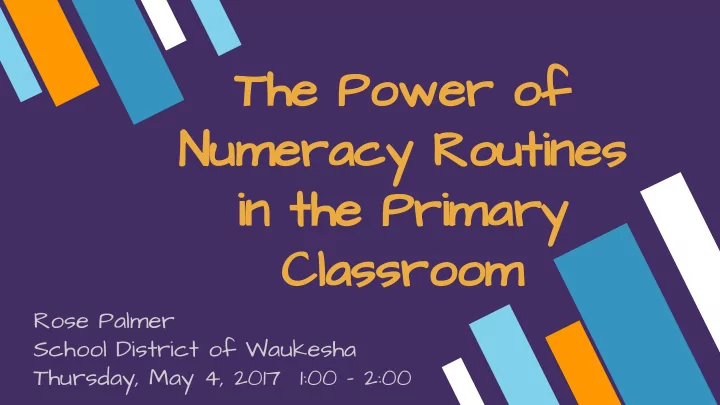

The Power of Numeracy Routines in the Primary Classroom Rose Palmer School District of Waukesha Thursday, May 4, 2017 1:00 - 2:00
Session Outcomes Participants will… » understand the purpose of doing regular numeracy routines » learn different types of numeracy routines » engage in samples of numeracy routines
What is a Numeracy Routine? An oral warm-up activity of 3-5 minutes » Done on a regular basis » Focused on a content standard » Has students engaged with learning and critical thinking » Used in place of traditional warm-ups or reviewing of homework
Why Routines? » Allow for a focus on learning » Design and flow of the learning experience more predictable » Provide for a wide range of learners to access and use math practices » Support making sense of numbers » Support mental math calculations/fact fluency » Help to build critical math thinking habits » Support reasoning and explaining thinking » Support students learning from each other
Number Sense Routines » Visual Routines » Counting Routines » Numbers and Relationships » Number Talks » Problem Solving
Visual Routines Subitizing/Quick Images Using » Dot Cards (Regular and Irregular) » Five and Ten Frames » Rekenreks (bead rack)
Dot Cards Regular Irregular
Five/Ten Frames
Rekenreks
Counting Routines » Count Around » Choral Counting » Bizz-Buzz
Count Around » All students participate. » Everyone needs to listen to each other and count in their heads. » Provide wait-time for students. » Students develop fluency with counting and place value. » Teachers can record the numbers on the board to help with the noticing of patterns.
Count Around Variations » Start at any number and count forwards or backwards (by 1s, 5s, 10s, etc.) Ask “What number will Jane say?” or “Will we reach 20 by the time we go around the circle once?” or “If we start at 52 and count backwards, how many times will we go around the circle to reach zero?” Reminders: ● Start at numbers other than 1. ● Count on and off the decuple.
Count Around Variations Second Grade: » Each student picks a coin and keeps it visible. Count around adding the value of the coin. . Use coins appropriate to your grade level. Ex.: 1, 26, 31, 41, 42, 67...
Choral Counting » Counting aloud as a whole class » Use when learning a new counting sequence » Can start with visual supports (ie. hundreds chart, number line) and then gradually remove Variation: » Divide class into sections to count by (1s, 5s, 10s, etc.) and then direct which group is counting
Bizz Buzz » Determine number to focus on (ie. 3) » Students count around the circle counting by 1s. » When the count has the number 3 in it, say “Bizz”. Variation: » Do a second number (ie. 6) and say “Buzz” when the count has the number 6 in it.. » When the count has 3 and 6, instead of saying the number, you say “Bizz Buzz”.
Numbers and Relationships » Target Number » Guess My Number » Which one’s not like the others? » True or False? » Operation Estimation » Number Talks » Would you rather?
Target Number » Provide students with a target number. » Students think of as many ways as they can to represent the number. » Share out their thinking while teacher records.
Guess My Number » Give or select three clues about the number. Between 70 and 120 An even number Has 3 digits » Students think through possible numbers for a moment » Share with a partner » Share with whole group Variation: have students create clues to share
Which one’s not like the others? 12 24 17 42 Which one doesn’t belong?
Operation Estimation: Estimation 180
Operation Estimation: Where Am I? » On a number line, indicate where your selected number is located. » Students give possible answers. Teacher places their answers on the number line to help zero in on the number. ? 30 10
Operation Estimation: Could Be or Crazy? » Teacher makes a statement. » Students decide if the statement “Could be” true, or is “crazy” and explain their reasoning. » Examples: If all the students in our class held hands outside we would reach all the way around our building. There are 230 students in our school. There are 20 shoes in our classroom.
Number Talks Pre-planned string of problems that lead students to an understanding. Example: 9 + 1 = __ 9 + 2 = __ 9 + 3 = __ Resource:
True or False? 9 - 3 = 4 + 2 9:30 = 15 minutes before 10:00
Would you rather? Would you rather have: 2 nickels 1 dime
Problem Solving » Keep it short for an opening » Use CGI Problem types » Avoid students racing to a solution » Encourage working together » Facilitate productive discourse » Use a “warm-up” problem for the context of the main lesson’s problem
Problem Solving I have 10 apples. Some are red and some are green. How many are red and how many are green?
Questions?
Resources ● Which one doesn’t belong? Website ● Estimation 180 Website ● Would you rather? Website ● Visual Patterns Website
Thank you! Contact information: Rose Palmer rpalmer@waukesha.k12.wi.us @RBrunnerPalmer
Recommend
More recommend